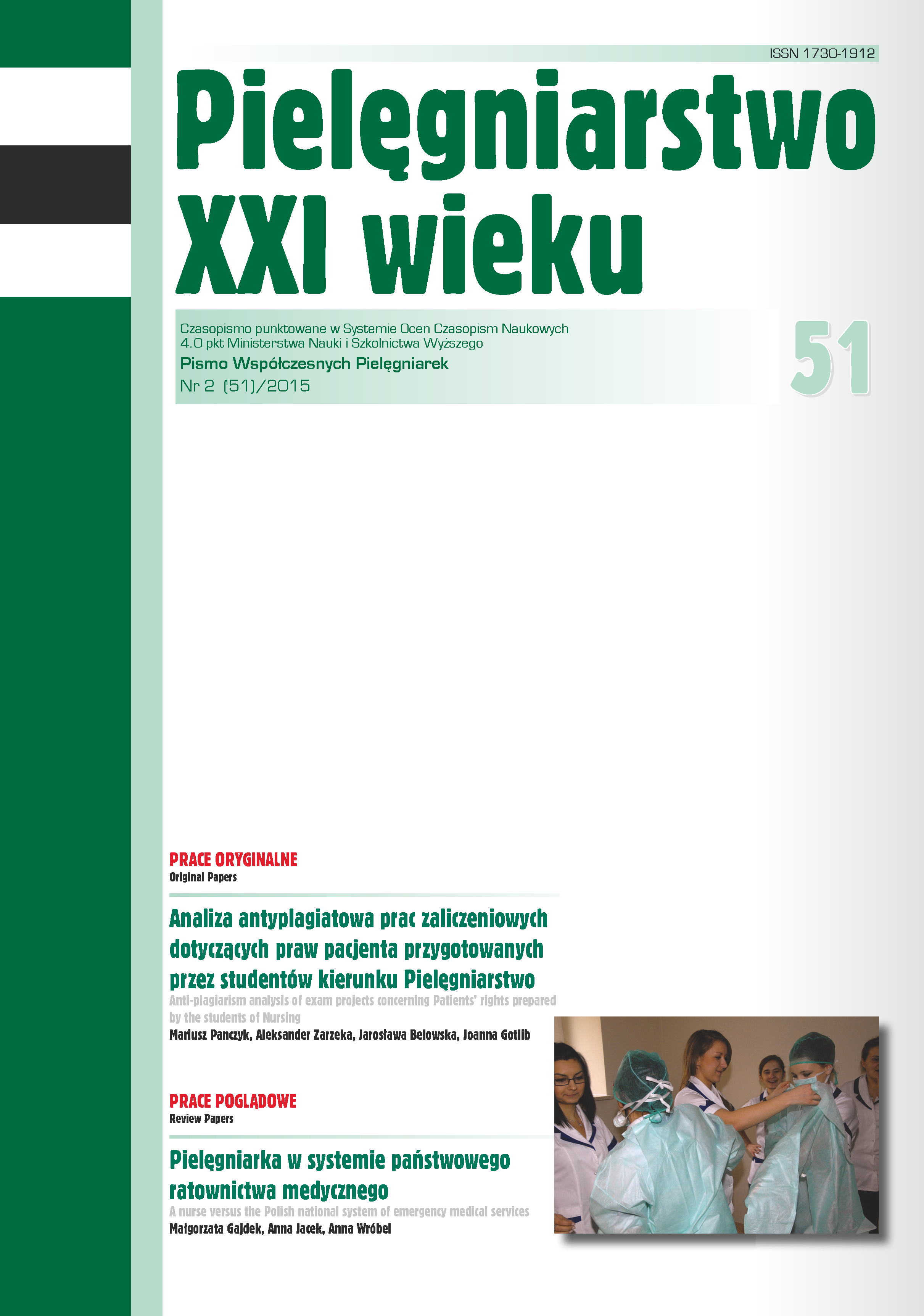Ryzyko nieukończenia studiów I stopnia na kierunku pielęgniarstwo – ocena predykcyjna
DOI:
https://doi.org/10.12923/p21w-2015-2/22Słowa kluczowe:
badania edukacji pielęgniarek, szkolnictwo pielęgniarskie wyższe, pomiar edukacyjny, zasady przyjęć na studiaAbstrakt
RYZYKO NIEUKOŃCZENIA STUDIÓW I STOPNIA NA KIERUNKU PIELĘGNIARSTWO – OCENA PREDYKCYJNA
Cel. Ocena ryzyka niepowodzenia podczas studiowania na kierunku pielęgniarstwo studiów I stopnia na Wydziale Nauki o Zdrowiu Warszawskiego Uniwersytetu Medycznego (WUM).
Materiał i metody. Badania przeprowadzon wśród 887 studentów (średnia wieku 20,0 ± 2,87 lat; 90% kobiet), którzy podjęli studia stacjonarne I stopnia na kierunku pielęgniarstwo na Wydziale Nauki o Zdrowiu WUM. Do oceny czynników predykcyjnych, które mają potencjalny wpływ na ryzyko nieukończenia studiów wykorzystano model nieliniowej estymacji dla funkcji regresji logistycznej z wyznaczeniem ilorazu szans (OR) dla każdego predyktora.
Wyniki. Trzy spośród czterech czynników socjo-demograficznych w istotny sposób wpływały na prawdopodobieństwo nieukończenia studiów: płeć – mężczyzna (OR = 3,035), Warszawa jako miejscowość ukończenia szkoły średniej (OR = 1,598) oraz stary typ egzaminu maturalnego (OR = 1,536). Dwa z trzech stosowanych kryteriów przyjęć było istotnymi predyktorami ryzyka niepowodzenia podczas studiów: język polski (OR = 1,021) i przedmiot dodatkowy (OR = 1,011).
Wnioski. Uzyskane wyniki badań predykcyjnych wskazują na niedostateczną trafności przyjętych kryteriów rekrutacyjnych w ocenie ryzyka niepowodzeń podczas studiowania na kierunku pielęgniarstwo. Konieczne jest dalsze monitorowanie oraz rejestrowanie przyczyn rezygnacji/usunięcia z listy studiujących w celu bardziej dokładnego oszacowania w przyszłości ryzyka niepowodzeń.
Bibliografia
1. Waters A. What a waste: Nursing Standard’s investigation into attrition rates from pre-registration courses produced some startling findings. Nurs. Stand. 2006; 20(23): 14-7.
2. Banks P, Kane H, Rae C, et al. Support for nursing and midwifery students: a special case? Nurse. Educ. Today. 2012; 32(3): 309-14.
3. Seago JA, Spetz J. Admission Policies and Attrition Rates in California Community College Nursing Programs. University of California at Berkeley: California Policy Research Center; 2003.
4. Wilson R, Eva K, Lobb DK. Student attrition in the Ontario midwifery education programme. Midwifery. 2013; 29(6): 579-84.
5. Andrew S, Salamonson Y, Weaver R, et al. Hate the course or hate to go: semester differences in first year nursing attrition. Nurse. Educ. Today. 2008; 28(7): 865-72.
6. Gillen S. Is enough being done to reduce undergraduate attrition rates? Nurs. Stand. 2012; 27(8): 12-3.
7. Sabin M, Taylor R, Tilley C. Untangling a complex issue: An overview of initiatives to support nursing and midwifery student recruitment, selection and retention in Scottish Universities. Nurse. Educ. Today. 2012; 32(4): 469-74.
8. White J, Williams WR, Green BF. Discontinuation, leaving reasons and course evaluation comments of students on the common foundation programme. Nurse. Educ. Today. 1999; 19(2): 142-50.
9. Cameron J, Roxburgh M, Taylor J, et al. An integrative literature review of student retention in programmes of nursing and midwifery education: why do students stay? J. Clin. Nurs. 2011; 20(9-10): 1372-82.
10. Pryjmachuk S, Easton K, Littlewood A. Nurse education: factors associated with attrition. J. Adv. Nurs. 2009; 65(1): 149-60.
11. Day R, Paul P, Boman J, et al. Proposal to support the strategic plan to implement the Canadian nursing advisory committee recommendations. Ottawa Ontario: Canadian Nurses Association; 2005.
12. Mulholland J, Anionwu EN, Atkins R, et al. Diversity, attrition and transition into nursing. J. Adv. Nurs. 2008; 64(1): 49-59.
13. Deary IJ, Watson R, Hogston R. A longitudinal cohort study of burnout and attrition in nursing students. J. Adv. Nurs. 2003; 43(1): 71-81.
14. Taylor R. Creating a connection: tackling student attrition through curriculum development. J. Fur. High. Educ. 2005; 29(4): 367-74.
15. McCallum J, Donaldson JH, Lafferty P. Can an interview score sheet assist with student selection onto the bachelor of science/diploma of higher education (adult) nursing programme? Findings from a pilot study. Nurse. Educ. Today. 2006; 26(7): 586-92.
16. McCarey M, Barr T, Rattray J. Predictors of academic performance in a cohort of pre-registration nursing students. Nurse. Educ. Today. 2007; 27(4): 357-64.
17. Ferguson E, James D, Madeley L. Factors associated with success in medical school: systematic review of the literature. BMJ. 2002;324(7343):952-7.
18. Kevern J, Ricketts C, Webb C. Pre-registration diploma students: a quantitative study of entry characteristics and course outcomes. J. Adv. Nurs. 1999; 30(4): 785-95.
19. Zwick R, Greif Green J. New Perspectives on the Correlation of SAT Scores, High School Grades, and Socioeconomic Factors. J. Educ. Meas. 2007; 44(1): 23-45.
20. Jowett S, Walton I, Payne S. Challenges and Change in Nurse Education: A Study of the Implementation of Project 2000: Executive Summary. Slough: National Foundation for Educational research in England and Wales; 1994.
Pobrania
Opublikowane
Numer
Dział
Licencja
Prawa autorskie (c) 2024 Mariusz Panczyk, Aleksander Zarzeka, Jarosława Belowska, Joanna Gotlib (Autor)

Utwór dostępny jest na licencji Creative Commons Uznanie autorstwa 4.0 Międzynarodowe.




